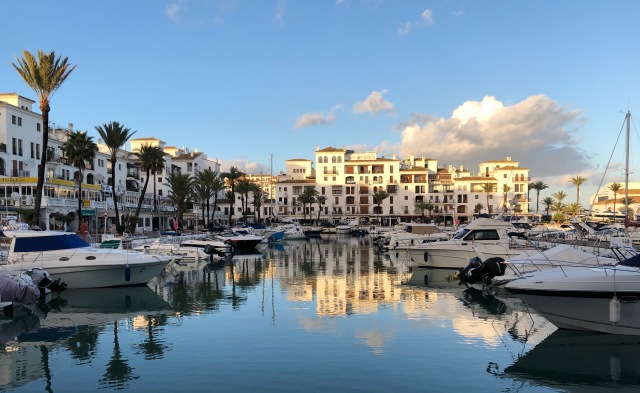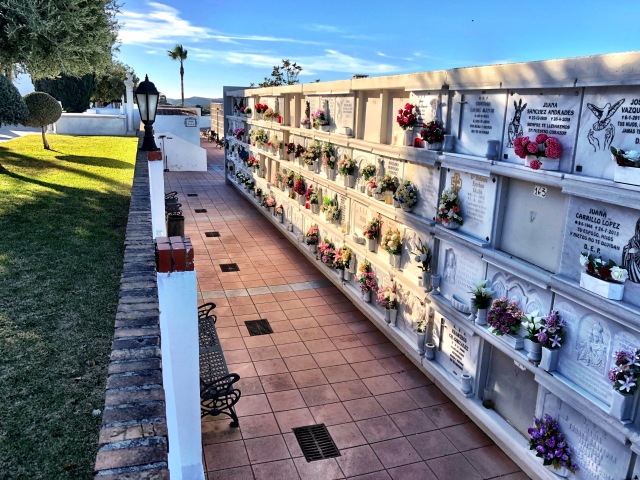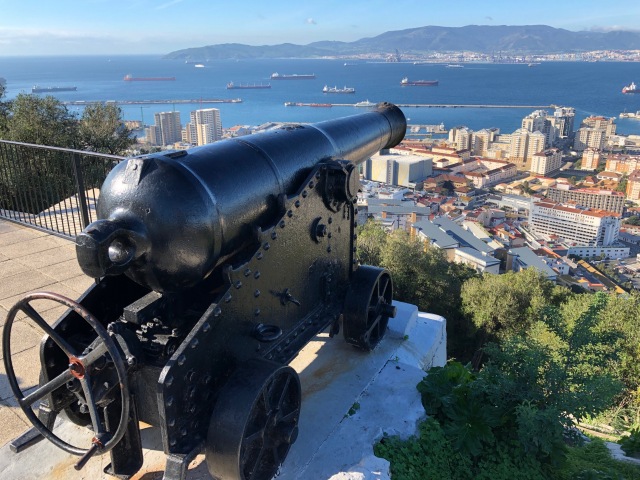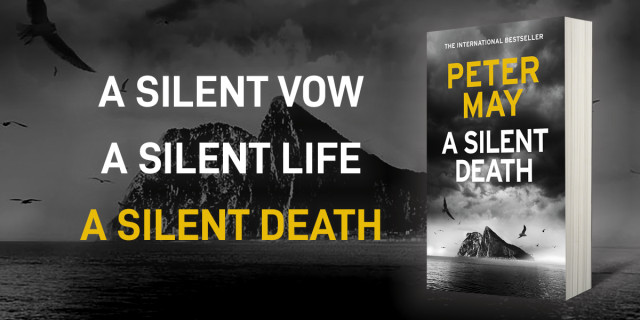click here to order now from Amazon.co.uk
BEHIND THE SCENES
A Silent Death will be published in January 2020, and before its publication, I thought I would share some of the research and development that went into the writing of the book.
The story is set in Spain, where a Scottish police officer has been seconded to the Spanish authorities to assist with the manhunt for a fugitive from British justice.
About eight years ago I bought an apartment overlooking the Mediterranean, a little to the west of the Spanish resort town of Estepona. Since then I have spent most of my winters there to escape the cold of my home in south-west France. In a little study looking out over a sparkling sunlit sea I have written my last six books. It is a part of Spain with which I have become very familiar and I have wanted to write about it for some time.
I should mention that I have had a love affair with Spain ever since meeting two sisters at a resort on the Costa Brava when I was a young teenager in the early sixties. They were from Barcelona – Cristina and Nurita – and I borrowed their names for the characters of the young Spanish policewoman and her sister. Those real-life sisters were the inspiration for the first book I ever wrote, between the ages of fourteen and sixteen. Needless to say, that first book was never published, but I have never forgotten Cris and Nuri, although I have never had any contact with them since. I have no idea if they are still alive, or will ever read this book.

“Puerto de la Contessa”, the classic holidaymaker’s experience of coastal Spain
THE PRINCIPLE CHARACTER
In A Silent Death I wanted to create a character who went against the grain of the classic hero. Not in the sense that he would be a drunk or a junkie or imbued with unpleasant characteristics or a questionable morality. But someone who was too damned clever for his own good.
John Mackenzie has an IQ that is simply off the scale, and as is so often the case with very clever people, absolutely no filter when it comes to social interactions. He says what he sees and thinks, because to him his view of the world is so self-evidently correct. He makes no allowance for the offence he might give, or the hurt he might cause. Not because he doesn’t care, but because he doesn’t understand the vulnerability of others to the brutal bluntness of his “truth”. His world is black and white, good and bad. There is no room for compromise.
For inspiration in the construction of this character I turned to my two brothers-in-law. Both are startlingly intelligent, and although they have never met have both been hugely successful in the world of computer system analysis – one in England, one in America.
One installed computer systems all over the world for a multi-national corporation, the other was employed as a freelance consultant by major organisations initialising untried computer systems in areas of financial or logistical sensitivity. Each had an unerring propensity for rubbing employers and co-workers up the wrong way. Both manage to offend friends and family with regular ease, never with intent, but always with surprise and regret when the effect of their words becomes belatedly apparent.
Since retirement, one has developed a hobby of studying languages and taking university degrees in a whole range of arcane subjects, like quantum physics, and astronomy. The other has found part-time employment in an industry which makes use of his astonishing ability to absorb and remember facts.
The latter has read the manuscript of “A Silent Death”. I often give him copies of my manuscripts to proof read because of his amazing memory and attention to detail. He picks up the tiniest of errors that the rest of us have missed. I think it would be fair to say that he recognised elements of himself in the character of Mackenzie, not least his obsessive insistence that all the shirts in his wardrobe must have a breast pocket capable of accommodating his mobile phone.

Main street of “Marviña”, where John Mackenzie is billeted in a local hotel
DEAF AND BLIND
One of the other main characters in A Silent Death is deaf and blind.
I first developed a consciousness about the phenomenon of deaf-blindness after watching a TV ad appealing for money for a deaf-blind charity. I wondered what on earth it must feel like to be deaf AND blind. It was unthinkable. To lose both primary senses and become trapped within yourself, your own body becoming a prison confining you in a world of darkness and silence.
I began research on the subject and discovered that it was more prevalent than one might expect. There are nearly 400,000 sufferers around the world, with that figure expected to rise to 600,000 in the next fifteen years. One of the most common causes is a genetic disease known as Usher Syndrome in which the victim develops partial or total hearing loss that worsens over time.
I decided to explore this illness through the character of a middle-aged woman, Ana, delving into her experience through a first person narration. Although not the principal character, she is central to the story. We discover that she was afflicted in early childhood with hearing problems, then diagnosed with Usher Syndrome in her teens, when she developed “night blindness”, which is often a precursor to vision loss caused by a disease known as retinitis pigmentosa, or RP. We accompany her on her nightmare journey into complete hearing loss and total blindness, and through her limited senses learn first hand about the book’s main antagonist when he takes her hostage.
For inspiration, and an authentic take on what it might be like to be deaf and blind, I delved into a book called “Deaf-Blind Reality – Living the Life”, edited by Scott M Stoffel, himself a deaf-blind sufferer. It presented extensive interviews with 12 victims from around the world, describing their experiences from childhood to adulthood, and sometimes old age, and gave me an extraordinary insight into their world. A world of bullying and neglect, by peers, and teachers, and society in general. It made me angry, and even more determined to cast light on their suffering through Ana.
The only channel of communication for deaf-blind sufferers with the world around them has come with the development of technologies that provide braille screens that allow them to surf the internet and exchange messages with others. There is even a service that enables telephone conversations via an operator who can pass on vocal or braille messages and respond in kind. But with so comparatively few sufferers worldwide, investment in finding medical solutions is tiny, and the hope of a future cure equally so.
THE SETTING
The book takes place in the south of Spain.
But not the Spain of sun, sea and sand that characterises the British holidaymaker’s image of the Costa del Sol. I wanted to get under the skin of this superficially beautiful part of the world, lifting stones to reveal the flip side of the seaside paradise depicted in travel agents’ brochures. To write about the “Costa del Crime”, that monicker so beloved of the tabloid headline writers. The reality that lurks just a few streets away from the seafront facades of bars and restaurants that look out on crowded beaches. A much darker world of drug-running and people trafficking. Of gangs and violence and the seeds of social unrest sown by a turbulent history of Moorish occupation and Catholic resistance.

Leaving the coast and heading into the mountains, the town of “Marviña” nestles in the hills.
Much of this other side of southern Spain was revealed to me during an interview with the chief of police in a hill town which is the administrative centre for a length of coastline that stretches east and west along the south coast, and north towards its mountainous interior. He happily introduced me to his handgun and holster, before taking me on a detailed tour of the police station. There were interview rooms and detectives’ offices, a gun room, and an evidence room where he laid out a huge array of lethal weapons seized during recent raids on local drugs gangs. Parts of the town, it seemed, were virtually no-go areas for the police. Derelict buildings – in fact, housing developments unfinished since the financial collapse of 2007/8 – had been taken over to become the headquarters of such gangs.
But these gangs are not just operating at street level. They are trafficking industrial quantities of drugs – heroin and cocaine. The police have trouble arresting gang members for more than minor possession. The big drugs hauls are sent out into the hills, to be stored in the barns and outhouses of peasant farmers who are coerced into cooperation. While I was researching the book, a whole family of innocent farmers was slaughtered by gang members when they went to retrieve drugs from the wrong farm by mistake.

“Marviña” with its view across the hillside vineyards to the sea
People trafficking, too, is a booming industry – less lucrative perhaps than drugs, but also less risky, with smaller sentences for those who are caught.
Increasingly boats are arriving along the south coast of Spain from North Africa – a relatively short crossing. There are many reports of sunbathing holidaymakers startled to see ragged lines of illegal immigrants piling off ramshackle boats that have washed up on the beaches. Clutching their meagre possessions, they quickly melt away into the hills beyond, where they are met by the people traffickers who guide them to temporary accommodation in any one of the hundreds of abandoned developments that pepper the coastline.
In the early two thousands, developers seemed to believe that there would be no end to the influx of wealthy Russians and Europeans flocking to the sun to buy apartments. But with the collapse of financial institutions worldwide towards the end of the decade, both money and buyers dried up, and hundreds of developments were simply abandoned. Some had only just been started, others were near completion. All are now crumbling in the searing heat of the sun, and nature is gradually reclaiming what had been taken from it. Cranes hired during the boom stand idly, like so many lost dinosaurs, looming over these scars on the landscape – the companies that owned them long since gone bust, just like the companies who hired them. Such places can be scary and dangerous.
The influence of a new generation of moneyed Russians is plain to see all around. Many of the billionaire yacht owners who dock their boats in the marina at the fashionable Puerto Banus are Russian. There are Russian clubs and restaurants, and more and more apartments are being snapped up by Russian tourists. Vladimir Putin himself is rumoured to own a large estate in the hills behind Marbella, flying in by helicopter from his yacht anchored out in the bay.
THE POLICEWOMAN
During my visit to the police station, I met a young policewoman who was wheeled in by the police chief to show me her uniform. She became the model for the other principal character in the book, Cristina – a young, married policewoman with a ten-year-old son, a crumbling marriage and a sister who is undergoing treatment for breast cancer. In a still male-dominated society where policewomen are employed only to meet the requirement for someone to search female suspects, juggling the responsibilities of a mother, wife and police officer is an almost impossible task. In my story Cristina is struggling to keep her head above this turbulence when she is attached, unwillingly, to John Mackenzie who has been sent by the National Crime Agency in the UK to track down and bring back a fugitive from British justice. A hard-working, honest and down-to-earth woman, she is unprepared for the social ineptitude of her new partner, or for a confrontation with death that will change her life.
A substantial element of Cristina’s character was based on my local research assistant, a divorced mother of a young son living in a small apartment in the administrative town which became my fictitious Marviña in the book. I used her chaotic apartment as the model for Cristina’s (she recognised it immediately when she read the manuscript), and I borrowed the name of her son, Lucas, for the character of the policewoman’s boy. She introduced me to the mysteries of the Spanish funeral, and the centuries old culture which still shapes the people there.

“Marviña” Cemetery
GIBRALTAR
The final part of the book takes place in Gibraltar, that giant rock which casts its ubiquitous shadow all along the southern Spanish coast. It is always there, somehow, in the telling of the story, and seemed like the perfect setting for the denouement of the book.
I made two visits to The Rock. The first was to gain a general impression of this outpost of a long lost British Empire, where almost 96 percent voted to remain in Europe – only to be dragged out against their will. A febrile sense of uncertainty suffused the atmosphere of the place when I was there, with the prospect of the reintroduction of a hard border with Spain ruining the lives and careers of many thousands of people living in the territory. I was surprised to discover that while its residents steadfastly call themselves British, the ethnicity of the population is hugely diverse, with many deriving from a range of other European and African countries such as Italy, Portugal, Greece, Malta and Morocco. Only 13 percent come from the UK, with little more than twice that number possessing British surnames. And yet as you step across the border from Spain, almost the first thing you see is an old-fashioned red British telephone box.

Gibraltar
My second visit took me high up on the rock to research the detailed specifics of the story’s end. But I won’t go into details here, because I don’t want to spoil the book for you!

View from the summit of The Rock
A Silent Death – available from Amazon.co.uk




Hi Peter,
What a wonderful thing to read about the ‘guts’ of the making of a book. I was mesmerised by the way the book came together, and I can’t wait to read it as soon as it comes out on audible. I like to do other things while I’m ‘reading’ a book, as my hands cannot keep still for a moment! I look forward to future books. A hearty thank you for a surprise e mail that left me wanting to read the book NOW.
Hi Lily-Maie, I’m a big fan of audio books, too, especially on long journeys. The audio book of “A Silent Death” will be available from January 9th, read as usual by the incomparable Peter Forbes.
Thanks for sharing this. I have hijacked it and used it (with proper attribution, of course) as an admirable description of the writing process on my blog – thanks!
LInda Conn Amstutz
Author of the new novel “The Bicycle Messenger” Find it on Amazon – http://mybook.to/Bicyclemessenger
>
👍
Can’t wait! Have loved each and every one of your books! They have been very instrumental in our decision to have a couple of holidays in the Outer Hebrides! Looking forward to the new one as I lived in Gibraltar for three years when my dad was stationed there on the RN.
Enjoy, Tessa!
Love all your books Peter and have recommended them to friends. I live in La Alfoquia a small village in Spain about 20 mins from Mojacar on the coast. I also got married in Gibraltar in 2005 so
am eagerly awaiting this book. Keep writing please.
Regards Maggie
Hope you’ll enjoy it, Maggie!
Hi Peter, I was driving home on 9/1/2020 and I heard you being interviewed on the radio in relation to this book. You came across very well. I was fascinated to hear that you had read a book of testimonies from/about people who were born blind and deaf. I would really like to be able to read about their experiences. Would you by any chance know the details (title/author) of the book? Kind regards, Phil
Hi Philip. The title of the book is “Deaf-Blind Reality – Living the Life”, edited by Scott M Stoffel.
Hi Peter, thank you very much for the information. Much appreciated.
I am reading this at the moment and thoroughly enjoying it as I have all the other Peter May books I’ve read. I lived in southern Spain for five years and this brings back many memories. Superb.
Thanks, Julia.